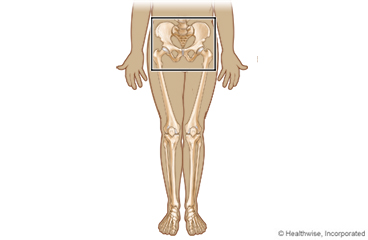
Overview
A hip sprain occurs when you stretch or tear ligaments around your hip. Ligaments are tough tissues that connect one bone to another. You can injure your hip in a fall, when you run, or during sports that involve twisting or sudden direction changes, such as basketball or soccer.
Most minor hip sprains get better with treatment at home.
Follow-up care is a key part of your treatment and safety. Be sure to make and go to all appointments, and call your doctor if you are having problems. It's also a good idea to know your test results and keep a list of the medicines you take.
How can you care for yourself at home?
- If your doctor gave you crutches or a walker, use them as directed.
- Rest and protect your hip. Try to stop or reduce any action that causes pain.
- Put ice or a cold pack on your hip for 10 to 20 minutes at a time. Try to do this every 1 to 2 hours for the next 3 days (when you are awake) or until the swelling goes down. Put a thin cloth between the ice and your skin.
- Be safe with medicines. Read and follow all instructions on the label.
- If the doctor gave you a prescription medicine for pain, take it as prescribed.
- If you are not taking a prescription pain medicine, ask your doctor if you can take an over-the-counter medicine.
- For the first day or two after an injury, avoid things that might increase swelling, such as hot showers, hot tubs, or hot packs.
- After 2 to 3 days, put a heating pad (set on low) or warm moist cloth on your hip before you do light stretches.
- Do exercises to make your hip stronger, as directed by your doctor or physical therapist.
- Return to your usual level of activity as your hip gets better.
When should you call for help?
Call your doctor now or seek immediate medical care if:
- Your pain is worse.
- You cannot walk or stand without help.
- You have signs of infection, such as a fever or increased pain, swelling, redness, or warmth in your hip.
- You have signs of a blood clot, such as:
- Pain in your calf, back of the knee, thigh, or groin.
- Redness and swelling in your leg or groin.
- You have tingling, weakness, or numbness in your leg, foot, or toes.
Watch closely for changes in your health, and be sure to contact your doctor if:
- Your pain does not get better in 2 or 3 days.
- You still have pain after 2 weeks.
Where can you learn more?
Go to http://www.healthwise.net/patientEd
Enter G946 in the search box to learn more about "Hip Sprain: Care Instructions".
Current as of: July 31, 2024
Author: Ignite Healthwise, LLC Staff
Clinical Review Board
All Ignite Healthwise, LLC education is reviewed by a team that includes physicians, nurses, advanced practitioners, registered dieticians, and other healthcare professionals.

